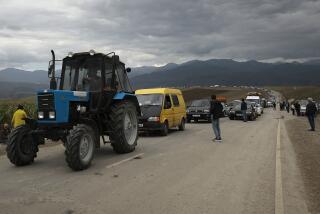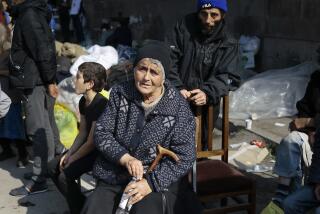Up to 100,000 Azerbaijanis Reportedly Fleeing Armenians : Transcaucasia: Iran is said to be refugees’ goal. They were displaced by an Armenian offensive launched from enclave of Nagorno-Karabakh.
- Share via
MOSCOW — An estimated 80,000 to 100,000 Azerbaijanis, forced to flee their homes by a massive Armenian offensive in southwestern Azerbaijan, are heading toward the Iranian border as the ethnic war in Nagorno-Karabakh widens into a full-scale international conflict.
Up to 2,000 Azerbaijani refugees have already crossed into Iran, and thousands of people are streaming toward the border behind them, reported Mahmoud Said, the U.N. representative in Baku, the Azerbaijani capital.
So far, Iran has avoided interfering in the 5-year-old Armenian-Azerbaijani conflict. But a sudden influx of refugees--and possibly retreating Azerbaijani soldiers--could destabilize the Iranian-Azerbaijani border and further complicate peace efforts, Russian and Western analysts said.
“Neither Iran nor we want to see these refugees cross the border, but this threat is quite real,” said Rafael D. Guseinov, Azerbaijan’s representative in Moscow.
“The Armenians are trying to drive refugees across the border on purpose, not only in order to gain more territory but also . . . to aggravate the situation in Azerbaijan,” Guseinov charged.
Officials in Nagorno-Karabakh, an Armenian enclave inside Azerbaijan, say that the areas under attack have been used to launch offensives against their villages and that their only goal is to demilitarize them.
Armenians now control about one-fifth of Azerbaijani territory--a humiliating setback for the Azerbaijani leadership that came to power in June promising to drive the Armenians out.
The war over Nagorno-Karabakh began after Armenian nationalists demanded independence for Karabakh in 1988. The ensuing ethnic fighting has killed about 15,000 people and created nearly a million refugees on both sides.
The 100,000 Karabakh Armenians have long been seen as the underdog in their battle against 7 million Azerbaijanis, but since February the war has turned sharply in their favor. Armenians captured the last major Azerbaijani-controlled town in Karabakh on June 27.
Then they began to drive deep into Azerbaijan proper, apparently aiming to create a defensible buffer zone around Nagorno-Karabakh. So far, the main targets have been cities and mountaintops from which the Azerbaijanis have lobbed shells into Karabakh.
On July 23, the Karabakh forces captured Agdam, an Azerbaijani city of 60,000. Fizuli, with a prewar population of 40,000 and a strategic location about 15 miles from the Iranian border, fell Monday. By Tuesday, Armenian forces controlled 50 villages in the Fizuli region, Azerbaijan’s Defense Ministry said.
And Azerbaijani troops were retreating from the southern city of Jebrail, Interfax said Tuesday. The western cities of Kubatly and Zangelan were also under fire, according to Said of the United Nations.
Karabakh Foreign Minister Arkady Gukasyan, in a telephone interview on Saturday, said his forces control the strategic heights around each city and could capture them but that commanders have been ordered not to enter them.
“We had to put an end to the constant bombardment of our capital, Stepanakert, from these towns, and we did,” Gukasyan said.
To mask its defeat, Gukasyan said, “the Azerbaijani leadership has launched a wild propaganda campaign to make us look like a bloodthirsty aggressor in the eyes of the world.” He said reports of refugees fleeing to Iran are false and “clearly directed at pulling Iran into the conflict.”
The Karabakh forces are estimated at about 40,000 troops--roughly one-third the size of the Azerbaijani army, but far better trained, disciplined and motivated.
Azerbaijan’s Guseinov said the Karabakh units are stretched too thin to control the territory they have captured. Instead, he charged, they are simply driving Azerbaijani civilians out by plundering and burning villages.
Analysts said the Azerbaijani army is demoralized, rife with corruption and factionalized among units loyal to a dozen different regional warlords.
A senior Azerbaijani Foreign Ministry official, who also spoke on condition of anonymity, said the Armenians could probably march to Baku if they wished.
“We never had such a grave situation, but I am afraid it will get even worse, because the world community does not seem willing to restrain Armenia,” the official said.
Much of southwestern Azerbaijan is already deserted. The few roads still open lead only to Iran, with people traveling south on them herding their cattle and carrying their mattresses, Said reported.
Thousands of refugees are camped about six miles from the Araks River, which marks the border with Iran, he said, adding that the river is shallow enough that desperate refugees could probably swim across.
More to Read
Sign up for Essential California
The most important California stories and recommendations in your inbox every morning.
You may occasionally receive promotional content from the Los Angeles Times.













